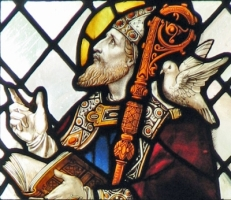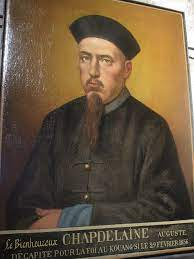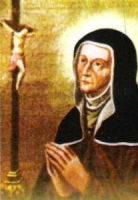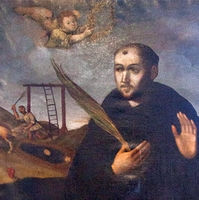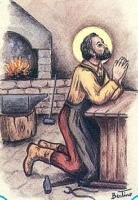St. Herculaflus
Feastday: March 1
Death: 549
Bishop of Perugia, Italy, beheaded by King Totila of the Ostrogoths. He is probably the same Herculanus sent to Perugia from Syria to evangelize the region.
St. Aubin
Feastday: March 1
Albinus, also known as Aubin, entered the monastery of Tincillac when a youth, was elected Abbot when he was thirty-five, and was named Bishop of Angers in 529. He was known for his generosity to the sick and the indigent, widows, and orphans, for his work in ransoming slaves, and for his holiness and the many miracles he is reputed to have performed both during his lifetime and after his death. His feast day is March 1.
St. Suitbert of Kaiserwerdt
Feastday: March 1
Patron: of Germany
Birth: 647
Death: 713
Swithbert, a monk from the English region of Northumbria, immigrated to Ireland, where he became a disciple of Saint Egbert in the monastery of Rathmelsigi. Described by his contemporary Saint Bede as a "humble-hearted" religious, Swithbert was one of twelve monks of Rathmelsigi sent by Egbert on a mission to evangelize the Netherlands. Among his companions was the famed missionary, Saint Willibrord. After winning the conversions of many pagans by his zeal, Swithbert was consecrated regionary bishop for this mission in 693. Thereafter he expanded his field of labor into western Germany. Here he was successful for a time, but in the end his efforts were thwarted by a Saxon invasion. Swithbert saw in this misfortune an opportunity to withdraw from the world and prepare himself spiritually for death. He founded a monastery on an island along the Rhine, where the town of Kaiserswerth now stands, near Dusseldorf, Germany. Swithbert spent the rest of his life in the Kaiserswerth monastery.
Saint David of Wales
புனிதர் டேவிட்
(St. David of Wales)
ஆயர்:
(Bishop)
பிறப்பு: கி.பி. சுமார் 500
கேர்ஃபை, பெம்ப்ரோக்ஷைர், வேல்ஸ்
(Caerfai, Pembrokeshire, Wales)
இறப்பு: மார்ச் 1, 589
செயின்ட் டேவிட்'ஸ், பெம்ப்ரோக்ஷைர், வேல்ஸ்
(St. David's, Pembrokeshire, Wales)
ஏற்கும் சமயம்:
ரோமன் கத்தோலிக்க திருச்சபை
(Roman Catholic Church)
கிழக்கு மரபுவழி திருச்சபை
(Eastern Orthodox Church)
ஆங்கிலிக்க ஒன்றியம்
(Anglican Communion)
முக்கிய திருத்தலங்கள்:
புனிதர் டேவிட் பேராலயம், பெம்ப்ரோக்ஷைர், வேல்ஸ்
(St. David's Cathedral, Pembrokeshire, Wales)
நினைவுத் திருநாள்: மார்ச் 1
பாதுகாவல்:
வேல்ஸ் (Wales)
பெம்ப்ரோக்ஷைர் (Pembrokeshire)
புலால் உண்ணாதவர்கள் (Vegetarians)
கவிஞர்கள் (Poets)
அயர்லாந்திலுள்ள நாஸ் (Naas in Ireland)
புனிதர் டேவிட், ஆறாம் நூற்றாண்டின் "மினிவ்" (Mynyw) மறை மாவட்டத்தின், (தற்போதைய “செயின்ட் டேவிட்ஸ்” (St Davids) ஆயர் ஆவார். இவர் வேல்ஸ் மாநிலத்தின் பாதுகாவலரும் ஆவார்.
மரபுகளின்படி, இவர் பிரிட்டிஷ் நாட்டின் புனிதர்களில் மிகவும் பிரபலமான புனிதர் “நான்” (Saint Non) என்பவரது மகனும், “செரேடிகியோன்” (Ceredigion) நாட்டின் அரசனான “செரேடிக் அப் குநேட்டா” (Ceredig ap Cunedda) என்பவரின் பேரனும் ஆவார்.
மத குருவாக குருத்துவ அருட்பொழிவு பெற்ற இவர், மறை போதனை செய்வதில் வல்லவராக இருந்தார். இவர் துறவற மடங்கள் பலவற்றை நிறுவினார். தமது தலைமை துறவற மடத்தினை 'வேல்ஸ்' மாநிலத்தின் தென்மேற்குப் (Southwestern Wales) பிராந்தியத்தில் நிறுவினார். அவரது அன்றாட வாழ்க்கையின் ஒழுங்கு முறைகள் மிகவும் கடினமானதாயும் தீவிரமானதாகவும் இருந்தன என்பர். அவர் தமது அன்றாட உணவை தினமும் நகருக்குள் சென்று பிச்சை எடுத்தே உண்டார். அதன் பொருட்டு, கைவண்டியை எருதுகளின் அல்லது குதிரைகளின் உதவியின்றி தாமே இழுத்துச் செல்வார். மிகவும் சாதாரணமாக, உப்பு மட்டுமே சேர்க்கப்பட்ட ரொட்டியும் நீரும் மட்டுமே அருந்தினார். புலால் உண்பதை கண்டிப்பாக தவிர்த்தார். மாலை வேளைகளில் செபிப்பதுவும், புத்தகங்களைப் படிக்கவும் எழுதவுமே செய்தார். தமக்காக எந்தவொரு பொருளையும் வைத்துக்கொள்ளவில்லை. "என்னுடைய புத்தகம்" என்று சொல்வதைக்கூட குற்றமாக கருதினார். தமது துறவற மடங்களில் தங்கியிருந்து தம்மைப் பின்பற்றிய துறவியரும் அவரைப்போன்றே கட்டுப்பாடுகளுடன் வாழவேண்டும் என்று எதிர்பார்த்தார்.
டேவிட் ஒருமுறை, "ல்லன்டேவி" (Llanddewi) என்றோர் கிராமத்திலே பெரும் மக்கள் மற்றும் துறவியர் கூட்டத்தினரிடையே மறை போதனை செய்து கொண்டிருந்த போது, அவர் நின்றிருந்த பூமி, ஒரு குன்று போல் உயர்ந்ததாகவும், ஒரு வெண்புறா அவரது தோளில் வந்தமர்ந்ததாகவும் கூறுகிறார்கள். இது, டேவிடின் துறவு வாழ்க்கையில் நடந்த பெரும் அதிசயங்களில் ஒன்று என கூறப்படுகின்றது.
இவர் மரித்தது, ஒரு மார்ச் மாதத்தின் முதல் தேதி, செவ்வாய்க் கிழமை என்று கூறப்படுகிறது. வேல்ஸ் மாநிலத்தின் தென் பிராந்தியத்தில் ஐம்பது தேவாலயங்கள் புனிதர் டேவிட் பெயரில் அர்ப்பணிக்கப்பட்டுள்ளன.
கிறிஸ்து அவரது ஆன்மாவைப் பெற்றுக்கொண்டதன் மூலம், துறவுமடம் சம்மனசுக்களால் நிரம்பப்பட்டதாக கூறப்படுகிறது.
Also known as
• David the Briton
• Degui, Dewi, Dewid, Dewm, Dewn, Dmui
Profile
Born to the Welsh royalty, the son of King Sandde, Prince of Powys, and of Saint Non, the daughter of a chieftain of Menevia (western Wales). Grandson of Ceredig, Prince of Cardigan. Uncle of King Arthur. Priest. Studied under Saint Paul Aurelian. Worked with Saint Columbanus, Saint Gildas the Wise, and Saint Finnigan. Missionary and founder of monasteries.
Following his contribution to the synod of Brevi in Cardiganshire, he was chosen primate of the Cambrian Church. Archbishop of Caerleon on Usk, he moved the see to Menevia. Presided at the Synod of Brefi which condemned the Pelagian heresy. Encouraged and founded monasteries. First to build a chancel to Saint Joseph of Arimathea's wattle church at Glastonbury.
After a vision in his monastery in the Rhos Valley, he set out next day with two monks to Jerusalem to aid the Patriarch. While there his preaching converted anti-Christians. Legend says that once while he was preaching, a dove descended to his shoulder to show he had the blessings of the Spirit, and that the earth rose to lift him high above the people so that he could be heard by them all. Another time when was preaching to a crowd at Llandewi Brefi, people on the outer edges could not hear, so he spread a handkerchief on the ground, stood on it, and the ground beneath rose up in a pillar so all could hear.
Born
c.542 at Menevia (now Saint David's), Wales
Died
• c.601 at Mynyw, Wales of natural causes
• interred in Saint David's Cathedral, Pembrokeshire, Wales
Canonized
1120 by Pope Callistus II
Patronage
• doves
• Wales
Saint Albinus of Angers
புனித_ஆல்பினுஸ் (470-550)
மார்ச் 01.
இவர் (#StAlbinus) பிரான்ஸ் நாட்டைச் சார்ந்தவர்.
சிறுவயது முதலே இறைவன்மீது ஆழமான பற்றுக் கொண்டிருந்த இவர் சின்சிலாக் என்ற இடத்தில் இருந்த துறவுமடத்தில் சேர்ந்து துறவியானார்.
துறவுமடத்தில் இவரது வாழ்க்கை பலருக்கும் எடுத்துக்காட்டாக இருந்தது. குறிப்பாக இவர் இறைவேண்டலிலும் ஒறுத்தல் முயற்சிகளிலும் சிறந்து விளங்கினார்; கீழ்ப்படிதலோடு வாழ்ந்து வந்தார். இதனால் இவர் தனது 35 ஆவது வயதிலேயே துறவு மடத்தின் தலைவர் ஆனார்.
இதற்குப் பின்னால் ஆங்கர்ஸ் என்ற இடத்தில் ஆயர் இல்லாமலிருந்தது. அங்கிருந்த மக்கள் இவர்தான் தங்களுக்கு ஆயராக வேண்டும் என்று ஒரு மனத்தோடு கேட்டுப் பெற்றுக்கொண்டார்கள்.
இவர் ஆயரான பின்பு ஏழைகள், நோயாளர்கள், கைம்பெண்கள் ஆகியோரை மிகவும் அன்பு செய்தார். அடிமைகளாக இருந்தவர்களை விலை கொடுத்து விடுதலை செய்தார். இவரால் பல வல்ல செயல்கள் நடந்தன. குறிப்பாக இவர் பார்வையற்றவருக்குப் பார்வையை அளித்தார்; இறந்துபோனவரை உயிர்த்தெழச் செய்தார்.
இப்படி புதுமை வள்ளலாக விளங்கிய இவர் 550 ஆம் ஆண்டு இறையடி சேர்ந்தார்.
Also known as
Aubin of Angers
Profile
Born to a noble family of Brittany. Pious child. Monk from his mid-20's into his 60's at Timcillac, which later renamed itself Saint Aubin's in his honour. Abbot for 25 years, beginning in 504. Bishop of the diocese of Angers, France from c.529. His episcopacy was known for his charity to the poor, widows and orphans, for his ransoming of slaves from their owners, his personal holiness, and the miracles he worked.
Custom of the day permitted consanguinary marriage. Albinus decried this as incest, and fought against it, making enemies in many powerful families who practiced it. He called councils at Orleans in 538 and 541, both of which condemned this and other morals offenses.
Legend says that when he visited Etheria, a woman imprisoned by King Childebert for bad debts, the woman threw herself at Albinus' feet, and pled for help. A guard made a move to strike her, but Albinus breathed in the man's face, and he fell dead. Etheria was soon released.
Another time Augin passed a prison tower in Angers, and heard the cries and moans of badly treated prisoners. He pled with the local magistrate for their release, but was refused. He returned to the tower and prayed in front of it; after several hours, a landslide brought down part of the tower, the prisoners escaped, followed Albinus to the church of Saint Maurichies, reformed their ways, and became model citizens and Christians.
The abbey of Saint Aubin in Angers was erected in his memory.
Born
469 at Vannes, Brittany, France
Died
• 1 March 549 of natural causes
• relics at the Cathedral of Saint Germanus in Paris, France
Patronage
• sick children
• against blindness
• against pertussis
• against pirate attacks
Saint Leolucas of Corleone
Also known as
• Leo Lukas
• Leo Luke
• Leoluca
• Leone Luca
• Leo Luke of Corleone
• Luke of Sicily
Profile
Born to a wealthy and pious family who raised cattle and sheep. Orphaned at an early age he devoted himself to managing the estate and supervising the herds. In the solitude of the fields he realized he had a call to religious life. He sold his estate, converted his assets to cash, gave the money to the poor, and became a Basilian monk at the San Filippo d' Agira monastery in the province of Enna, Sicily. He moved from Sicily to Calabria, Italy to escape the persecutions of invading Muslims, and joined a monastic community there. Pilgrim to Rome, Italy where he made a special point to visit the tombs of Saint Peter and Saint Paul. Abbot of a Basilian monastery of Corleone, Sicily. Lived 80 years as a monk. Leolucas' intervention is credited with saving the city of Corleone during the plague outbreak of 1575. The apparition of Leolucas and Saint Anthony prevented a Bourbon invasion of Corleone on 27 May 1860.
Born
c.815 to 818 at Corleone, Sicily
Died
• c.915 of natural causes
• miracles reported at his tomb
Patronage
• Corleone, Sicily
• Vibo Valentia, Italy
Saint Rudesind
Also known as
Rosendo, Rudesinde, Rudesindo, Rudesindus
Profile
Born to the Spanish nobility, son of Count Gutierre de Mendenez. Relative of Saint Senorina. Benedictine monk. Reluctant bishop of Mondonedo, Spain at age 18. Reforming bishop of Compostela, Spain replacing his corrupt cousin Sisnand. Led armies against invading Norsemen and Moors. When Sisnand escaped prison, he attacked Rudesind during Christmas Mass, and threatened to murder him. Rather than live as a prisoner himself, Rudesind retired from the bishopric. He founded several monasteries and abbeys, all under strict Benedictine Rule, including Saint John of Caaveiro Abbey and the Monastery of San Salvador de Celanova; he lived as a humble monk at each of these. Abbot of San Salvador de Celanova. Advisor to Church and political leaders. Reported miracle worker.
Legend says that during prayers at the church San Salvador on Mount Coruba, his mother received the knowledge that her son would be a holy man. She insisted that the boy be baptized at the church. It had no font, so one was loaded into a cart and hauled up the mountain. Halfway up the cart broke down - so the font continued up the hill under its own power.
Born
26 November 907 in Galicia, Spain
Died
1 March 977 at Celanova, Spain of natural causes
Canonized
1195 by Pope Celestine III
Saint Swithbert
Also known as
• Apostle of the Bructeri
• Apostle of the Frisians
• Swithbert the Elder
• Suidbert, Suitbert, Suitbertus, Swibert, Swidbert
Profile
Studied in Ireland with Saint Egbert of Rathemigisi. Benedictine monk. Preacher. Spiritual teacher of Saint Willeic. One of a group of twelve English missionaries led by Saint Willibrord of Echternach who worked in Friesland, a group of islands off the coast of the Netherlands, evangelizing the Frisians and Bructeri. Bishop in 693. Worked with Saint Wilfrid of York. Founded a Benedictine monastery at Werth on the Rhine (modern Düsseldorf-Kaiserswerth, Germany) where he lived the rest of his life under the direction of his co-worker missionary, Saint Velleicus who served as the abbot.
Born
c.647
Died
• 1 March 713 near Düsseldorf-Kaiserswerth, Germany of natural causes
• relics at monastery he founded at Werth, Germany
Patronage
• against angina
• against throat ailments
• angina sufferers
• Drevenack, Germany
• Germany
Saint Agnes Cao Guiying
Also known as
• Agnese Cao Kuiying
• Agnes Tsao Kou Ying
• Agnes Kouying Tsao
• Agnes Tsao-kouy
• Inés, Yiani
Additional Memorial
28 September (as one of the Martyrs of China)
Profile
Raised in a Catholic family, Agnes was a teenager when her parents died, and she moved from her home village to Xingyi. Married to a young farmer at age 18. Widowed two years later when her husband was martyred, she devoted herself to teaching catechism. At the request of Saint, Auguste Chapedelaine, she moved to the Guangxi province to help with the missionary work there. Along with teaching the catechism, she taught young women to cook, care for children and manage a home. For her work with the missionaries, she was imprisoned and tortured, then locked in a tiny cage and given a chance to save herself by renouncing her faith; she refused. Martyr.
Born
c.1821 in Wujiazhai, Guizhou, China
Died
1 March 1856 in Xilin, Guangxi, China of abuse, exposure and starvation
Canonized
1 October 2000 by Pope John Paul II
Blessed Christopher of Milan
Additional Memorial
7 March (Franciscans)
Profile
Nothing is known of the early life of Blessed Christopher. He joined the Dominican at San Eustorgio convent, Milan, Italy, and became a travelling preacher throughout Italy. Abbot at Our Lady of Mercy abbey in Taggai, Italy. He had the gift of prophecy, foreseeing plague, flood and invasion by Turks. Wrote four works on sermon preparation; the citations in them indicate extensive study of the early Church Fathers.
Born
1410 in Milan, Italy
Died
1484 at Our Lady of Mercy convent, Taggia, Italy of natural causes
Beatified
1875 by Pope Pius IX (cultus confirmed)
Pope Saint Felix III
Profile
Born to a Roman senatorial family. Great-grandfather of Pope Saint Gregory the Great. Married, father, and widower. Priest. Nothing else is known of his early life. Elected 48th pope.
At the time of his ascension the Eastern Church had been split by the Act of Union of Emperor Zeno, which tried but failed reconcile the Church and Eutychianism. Felix excommunicated the schismatic bishops and paved the way for re-union in 518, during the reign of Justinian. He drew up the conditions for the return of African Christians who had apostatized during the Vandal persecutions.
Born
at Rome, Italy
Papal Ascension
13 March 483
Died
• 1 March 492 at Rome, Italy of natural causes
• buried in Saint Paul's on the Ostian Way
Jared the Patriarch
Also known as
Jered, Yard
Profile
Old Testament patriarch. Member of the fifth generation following Adam and Eve. Father of Enoch. Lived to age 962.
Name Meaning
the descendant; the inheritor (hebrew)
Blessed Roger Lefort
Also known as
• Roger de Beaufort
• Roger de Ternes
• Roger le Fort
• Roger of Bourges
Profile
French noble, the son of Godefroy le Fort, the lord of Ternes, Limousin. Nephew of Cardinal de la Chapelle. Bishop of Orleans, France in 1321 while still a sub-deacon. Bishop of Limoges, France in 1328. Bishop of Bourges, France in 1343. Instituted a feast in honour of Mary‘s Immaculate Conception. His will he left all his property for the education of poor boys.
Born
c.1285 in the castle of Ternes near Guéret, Les Ternes, Creuse, France
Died
• 1367 of natural causes
• buried in the choir of the cathedral of Bourges, France
Blessed Giovanna Maria Bonomo
திருக்காட்சியாளர் யோஹான்னா மரியா போனோமோ Johanna Maria Bonomo OSB
பிறப்பு
15 ஆகஸ்டு 1606,
அசியாகோ Asiago, இத்தாலி
இறப்பு
1 மார்ச் 1670,
பாசான்னோ Bassano, இத்தாலி
முத்திபேறுபட்டம் : 9 ஜூன் 1783 திருத்தந்தை 6 ஆம் பயஸ்
இவர் கிளரிசியன் சபைச் சகோதரிகளால் வளர்க்கப்பட்டார். 1622 ஆம் ஆண்டு, புனித பெனடிக்டின் சபையில் சேர்ந்து தனது வார்த்தைப்பாடுகளைப் பெற்று துறவியானார். ஏறக்குறைய 50 வருடங்கள் மிகச் சாதாரணத் துறவியாக வாழ்ந்தார். அதன்பிறகு நவத்துறவகத்திற்கு பொறுப்பேற்று, நவத்துறவிகளை கவனித்து பராமரித்து வந்தார். 3 முறை இல்லத்தின் பொறுப்பாளர் துறவியாகவும் இருந்தார். இவர் தனது வாழ்நாளின் இறுதிவரை கடினமான நோயால் தாக்கப்பட்டு, உடல் அளவிலும், உள்ள அளவிலும் வேதனைகளை அனுபவித்தார். பொறுமையுடன் தன் உடல் வலிகளைத் தாங்கி இடைவிடாது செபித்தார். இவர் நோயுற்றிருந்தபோது நோய்களைத் தாங்கும் வல்லமையையும், சக்தியையும் திருக்காட்சியின் வழியாகப் பெற்றார். இவர் தான் கண்ட திருக்காட்சிகளை கைப்பட எழுதினார். இவைகள் அனைத்தும் அச்சிடப்பட்டு, இதன் வழியாக ஆண்டவரின் நற்செய்தி பரவியது என்று கூறப்படுகின்றது.
Also known as
• Jane Mary Bonomo
• Jeanne-Marie Bonomo
Profile
Educated by the Poor Clares of Trent, Italy. Benedictine nun at Bassano, Italy in 1622. She fell into ecstasy for the first time during the ceremony of her profession. Novice mistress. Prioress. Abbess three times. Bitterly persecuted by members of her own community for her dedication and mystical experiences; many thought them either heretical or a play for attention.
Born
15 August 1606 at Asiago, diocese of Vicenza, Italy
Died
1 March 1670 of natural causes
Beatified
9 June 1783 by Pope Pius VI
Blessed Bertrand of Fontaniva
Also known as
• Bertrand d'Orega
• Bertramo, Bertrando
Profile
As a young man, Bertrand gave up his worldly goods and became a pilgrim to the shrines in Rome, Italy. Near Fontaniva, he became overcome with some illness and sat down on the porch of a church. He flagged down a passing boy and had him find a priest. As soon as Bertrand finished making his confession, he died. The locals buried him in Fontaniva, and since they knew he had died in a state of grace, developed a devotion to him.
Born
latter 12th century Pomerania (in modern Germany)
Died
1 March 1220 outside Fontaniva, Italy of natural causes
Patronage
Fontaniva, Italy
Saint Leo of Rouen
Also known as
• Leo of Bayonne
• Leo of Carentan
• Leon, Leone
Profile
Raised in a pious family. Bishop of Rouen, France. Evangelist in Navarre and the Basque regions. Martyred by Saracen pirates. Legend says that a spring of water sprang up where he died, and that his body carried his severed head back to the place of his last sermon before finally collapsing.
Born
c.856 at Carentan, Normandy, France
Died
beheaded c.900 near Bayonne, France
Patronage
Bayonne, France
Saint Simplicius of Bourges
Profile
Married layman father of a large family; his wife was a member of the Roman senatorial Paladii family. His reputation for personal holiness led local bishops, led by Sidonius Apollinaris of Clermont, to choose him as bishop of Bourges, France c.470. Defended the Church against Arian Visigoths and attempts to weaken the Church by lay officials, a confrontation that was raging in the region at the time of his election. After years of his leadership bringing people back to orthodox Christianity, which led to civil authorities exiling Aryan leaders, Aryans captured, imprisoned and executed Simplicius. Martyr.
Died
1 March 477 in Clermont, France
Saint Albaud of Toul
Also known as
Aladius, Albaudius, Albin, Aubin
Profile
Priest. Friend of Saint Aprus of Toul. Bishop of Toul, Gallia Belgica (in modern France) in 507. For centuries, pilgrims to his relics received some of the vintage de Saint Albaud, a wine made at the monastery that received a blessing for its use in healing of pilgrims.
Born
late 5th century Gaul (in modern France)
Died
• c.525 in Toul, France of natural causes
• buried in the Saint-Aper Benedictine abbey church in Toul next to Saint Aprus
• relics enshrined in the mid-9th century
Saint Amandus of Boixe
Also known as
Amantius, Amant, Amand
Profile
Rather than go into business as his family wanted, Amand decided to take up arms against the Saracens. Setting sail for the front lines, his ship was blown back to show, and Amand took this as a sign that he should not be a soldier. He gave away all his possessions, became a hermit, then a monk, and then founder and first abbot of what became Saint Amand-de-Boixe monstery.
Seth the Patriarch
Profile
Old Testament patriarch. Third son of Adam and Eve, and the eldest son at home after the death of Abel by Cain. Lived to age 912.
While nothing else is known about him from Biblical sources, Jewish tradition says that Adam and Eve taught Seth the secret to resisting evil: when temptations began, he immediately went into fervent prayer; if the temptation was great, he would flee to an altar and as for God's support.
Saint Eudocia of Heliopolis
Also known as
Eudokia, Eudoxia
Profile
Courtesan who led a disolute youth. She converted, and led a life of great penance to make up for her early waywardness. Martyred in the persecutions of Trajan.
Born
• at Heliopolis in Coele-Syria
• her family was originally from Samaria
Died
beheaded in the 2nd century
Saint Albinus of Vercelli
Also known as
• Albin of Vercelli
• Albino of Vercelli
Profile
Bishop of Vercelli, Italy in 452, he took over a diocese in turmoil and ruins, and spent the rest of his life working to put it back in working order. Built a new cathedral over the ruins of the old one, and the tomb of Saint Teofrasto.
Patronage
Pella, Italy
Saint Ursus of Toul
Also known as
Orso, Ours, Ursinus
Profile
Bishop of Toul, Gallia Belgica (in modern France) c.490. Assigned Saint Vaast of Arras to bring Clovis I, king of the Salian Franks, to Christianity.
Born
Frankish
Died
• c.500 in Toul, France
• buried in the cemetery of Saint-Mansuy
• relics enshrined in the church of Saint-Mansuy de Fontenoy-le-Château in 1026
Blessed Agapios of Vatopedi
Profile
16th-century monk at the Vatopedi monastery. Hermit on Mount Athos. Captured by Turkish pirates, he was sold into slavery where he was chained and put to hard labour. Finally freed, he resumed his religious life first at Vatopedi, and then as a hermit on Mount Athos.
Saints Constantius and Faustus of Cologne
Profile
Two martyrs who died in Rome, Italy, and whose relics were transferred to and enshrined in Cologne, Germany in 1645. We know nothing else about them.
Saint Domnina of Syria
Profile
Consecrated virgin who lived in a shed, leaving only to attend Mass. She devoted her life to prayer and to caring for travellers. Known for keeping her face covered at all times and refusing to look at the faces of others.
Died
c.460 of natural causes
Blessed Pietro Ernandez
Profile
Mercedarian. Had the gift of tongues, which he used to preach to Saracens and convert many of them to Christianity. Tortured with hot tongs and martyred for his work.
Died
tied to a pole and shot with arrows on the road in Almeria, Spain
Blessed Aurelia of Wirberg
Profile
Born to the nobility. After the death of her father and brothers, Aurelia inherited the family estates and was besieged by offers of marriage. On the advise of her spiritual teacher, Blessed Otto of Cappenberg, she turned the family castle into a Premonstratensian convent from 1134 to 1148.
Born
12th century Germany
Blessed Gonzalo de Ubeda
Also known as
Gonzalo of Granada
Profile
Priest. Auxiliary bishop of Granada, Spain. Mercedarian Commander. Moved his house to Granada c.1500 and build a church and convent there.
Died
1538 in Granada, Spain of natural causes
Saint Lupercus
Also known as
Loubert, Luperc, Lupercio, Lupercius, Luperculus
Profile
Evangelizing second bishop of Eauze, France, converting many. Martyred by Dacian the governor during the pesecutions of Decius. Highly venerated in Tarbes, France; the old cathedral in Eauze was dedicated to him.
Born
probably in Spain
Died
3rd century
Saint Monan
Profile
Monk at Saint Andrew's abbey. Spiritual student of Saint Adrian, bishop of Saint Andrew's. Missionary to the Isle of May in the Firth of Forth area in Scotland. Missionary to Fife, Scotland. Murdered with a group of Christians by Danish raiders.
Died
murdered in 874 in the area of the Firth of Forth, Scotland
Blessed George Biandrate
Profile
Born to the nobility, the family of the counts of San Giorgio Canavese. Noted for his devotion to the Blessed Virgin Mary.
Born
Italy
Died
• 1483 of natural causes
• buried in the parish church of San Giorgio Canavese, Italy
Saint Antonina of Bithynia
Also known as
Antonina of Nicomedia
Profile
Tortured and martyred for refusing to sacrifice to pagan gods.
Died
sewn up in a sack and thrown into a pond to drown c.306 at Nicaea, Bithynia (in modern Turkey)
Saint Abdalong of Marseilles
Profile
Bishop of Marseilles, France in 716. He and his flock suffered from attacks by Saracens who had been brought in by Duke Mauront to combat the forces of Charles Martel.
Died
c.738
Saint Siviard
Also known as
Siviardus
Profile
Monk at Saint-Calais Abbey on the River Anisole in France where his father served as abbot. He served as abbot himself, and wrote a biography of Saint Calais, the founder of the monastery.
Died
c.729
Saint Marnock
Also known as
Marnan, Marnanus, Marnoc
Profile
Spiritual student of Saint Columba an Iona Abbey. Bishop. Kilmarnock, Scotland is named for him.
Born
Ireland
Died
c.625 at Annandale, Scotland
Blessed Bonavita of Lugo
Profile
Layman blacksmith, wheelwright and locksmith. Franciscan tertiary. Known for his deep prayer life and charitable works.
Died
1375 in Lugo, Italy of natural causes
Saint Librén
Profile
No certain information about this man has survived, but he is listed in very early martyrologies.
Born
latter 6th-century Ireland
Died
610 of natural causes
Saint Albin of Embrun
Profile
Bishop of Embrun, Gaul (in modern France) during the 5th to 7th century (records vary). Much of his time was spent fighting Arianism.
Blessed Claudius Gabriel Faber
Profile
Minim monk. Prior of his house. Martyred by heretics.
Died
1575 in Lunel, France
Saint Donatus of Carthage
Profile
Martyr.
Died
430 in Carthage, North Africa (modern Tunis, Tunisia)
Saint Hermes of Numidia
Profile
Martyred in the persecution of Maximian Herculeus.
Died
c.290
Saint Bono of Cagliari
Also known as
Bonus
Profile
Third-century bishop. Martyr.
Saint Adrian of Numidia
Profile
Martyred in the persecution of Maximian Herculeus.
Died
c.290
Abbey of Fontenelle
Also known as
• Abbey of Saint Wandrille
• Fontenelle Abbey
Founded
657
Article
Benedictine monastery in Normandy (Seine-Inférieure), near Caudebec-en-Caux, founded by Saint Wandrille. The basilica he erected was consecrated in 657, and was subsequently destroyed and rebuilt several times. After its destruction by Danish pirates in 862, the community moved to other centers. Fontenelle was restored in 966.
Fervor and learning characterized the monks, and many privileges were granted to them. The monastery was famed for its library and school, where calligraphy in particular, as well as letters, sciences, and the fine arts, were cultivated. The introduction of commendatory abbots in the 16th century lessened the prosperity of the abbey, but it enjoyed some of its earlier prestige when taken over by the Maurists in 1636.
The abbey was suppressed in 1791, and then sold the following year. From 1893 to 1901 it was held by the French Benedictines. The chapel of Saint Saturnin, also erected by Saint Wandrille, overlooks the abbey. It is one of the oldest ecclesiastical buildings in existence.
The commemoration on 1 March celebrates the founding and history of the abbey, and all the holy monks who have lived there, especially those who have been canonized or beatified.
Profiled Monks of Fontenelle
• Blessed Milo of Fontenelle
• Saint Ansbert of Rouen
• Saint Ansegisus
• Saint Bagne of Terouanne
• Saint Benignus of Flay
• Saint Condedus
• Saint Erembert of Toulouse
• Saint Fulk of Fontenelle
• Saint Genesius of Lyon
• Saint Gennard
• Saint Gerold of Evreux
• Saint Godo of Oye
• Saint Hermenland
• Saint Hugh of Rouen
• Saint Lambert of Lyon
• Saint Walter of Fontenelle
• Saint Wandrille of Fontenelle
Martyrs of Africa
Profile
A group of 13 Christians executed together for their faith in Africa. The only details about them to survive are ten names - Abundantius, Adrastus, Agapius, Charisius, Donatilla, Donatus, Fortunus, Leo, Nicephorus and Polocronius.
Martyrs of Antwerp
Profile
A group of Christians martyred together, buried together, and whose relics were transferred and enshrined together. We know nothing else but their names - Benignus, Donatus, Felician, Fidelis, Filemon, Herculanus, Julius, Justus, Maximus, Pelagius, Pius, Primus, Procopius and Silvius.
Died
• 2nd century Rome, Italy
• buried in the Saint Callistus catacombs in Rome
• relics enshrined in the Jesuit church in Antwerp, Belgium on 28 February 1600
Martyrs of the Salarian Way
Profile
A group of 260 Christians who, for their faith, were condemned to road work on the Salarian Way in Rome, Italy during the persecutions of Claudius II. When they were no longer needed for work, they were publicly murdered in the amphitheatre. Martyrs.
Died
shot with arrows in 269 in Rome, Italy
Martyrs Under Alexander
Profile
A large but unspecified number of Christians martyred in the persecutions of Emperor Alexander Severus and the praefect Ulpian who saw any non-state religion to be a dangerous treason.
Died
219
Martyrs of Eichstätt
Profile
Four Christians martyred and buried together, whose relics were rediscovered and enshrined togther. We know nothing else about them but the names Castus, Leontia, Livonius and Venerius.
Died
• in Rome, Italy
• buried in the Priscilla catacombs on the Via Salaria in Rome
• relics recovered in 1618
• relics enshrined in the Jesuit church in Eichstätt, Bavaria, Germany in 1622

